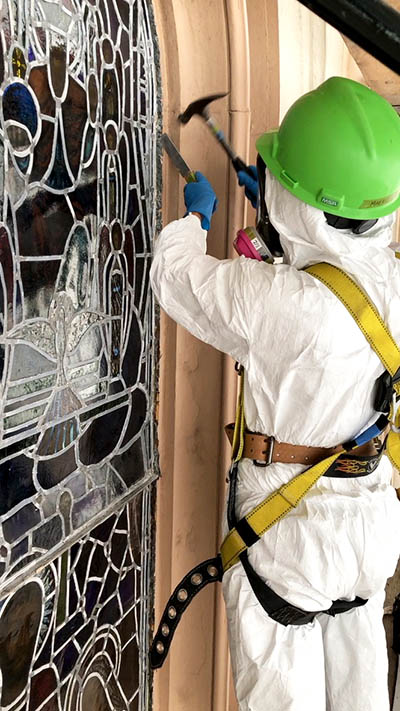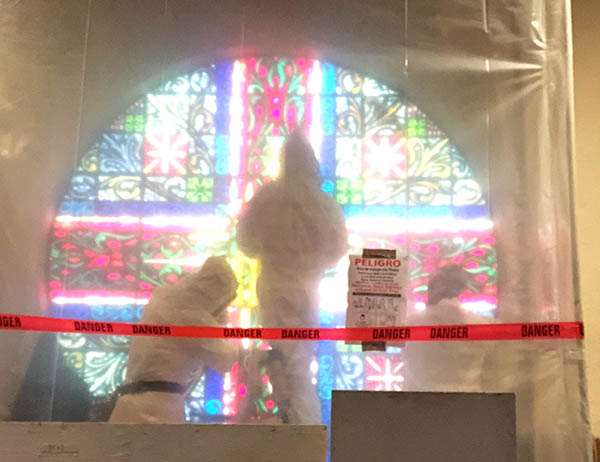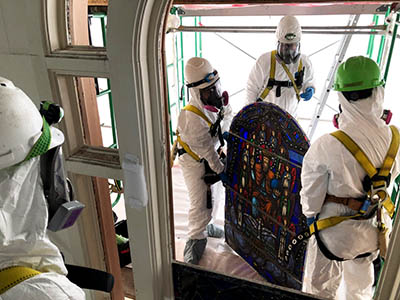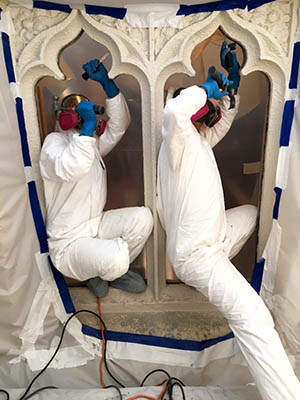
Ariana Makau in full PPE (personal protective equipment) removing an old, oxidized, stained glass window at St. Vincent de Paul in San Francisco, California.
Photo: Nzilani Glass Conservation
by Ariana Makau,
President, Nzilani Glass Conservation
Stained glass windows are often the crowning glory of a sacred space. Serving the dual purpose of art and architecture, they augment and enhance a space like few other architectural assets. Yet, for all their beauty, their primary purpose is to protect people from the elements. When windows start to bend or leak due to broken joints or cracked glass, most people notice the damage and call a specialist for help. What many people often miss is another key element—lead.
In fact, what is often referred to as “stained glass” is in truth “leaded art glass.” The stain refers to a specific technique: silver nitrate that actually stains the glass surface various hues of yellow. Other colors are provided by the glass itself, as well as applied paint or enamel. Simply put, most stained glass is leaded glass; but not all leaded glass is stained. Although the glass design is what people think of first, strips of lead “came” provide the structure and hold the individual glass pieces together. Both the glass and the lead are relatively inert in a newly created panel, so unless you touch the lead and fail to wash your hands afterwards, you can safely enjoy your windows.
Being around old stained glass—or repairing it—is a completely different matter. Lead oxidizes over time, creating a whitish grey powder on the surface. The powder can disperse from the windows onto sills, pews or tables in social halls and schools. It is often hard to distinguish from “normal” dirt or dust. Additionally, windows are set into the building with other materials: wooden stops, border putty, cement acting as stone set, or aluminum frames to name a few. Wherever these materials intersect, those areas also become lead-contaminated.

Nzilani crew members work within a containment unit to safely remove a window at Glide Memorial Church in San Francisco, California.
Photo: Nzilani Glass Conservation
Of course leaded glass windows add great value to the building—both historically and monetarily. Correctly preserving older windows is the right thing to do—albeit under correct health and safety precautions. Site work should always be undertaken by a leaded glass specialist who also has certified lead worker training.

The Nzilani crew works as a team both inside and outside with safety harness 50 feet up on scaffolding.
Photo: Nzilani Glass Conservation
Contrary to what many people believe, the highest exposure occurs when leaded windows are being removed, not when they are being repaired under the controlled conditions of an art studio. The work area should be contained, (i.e., separated) from the public—especially where children are present. If you can see people removing a window, then you are not protected. Although it may be a bit jarring to see scaffolding swathed in “shrink wrap” with zippered doors and signs stating “DANGER—Lead Work Area,” it’s for everyone’s safety. Lead workers are trained in wearing proper personal protective equipment (PPE) while safely removing the windows and cleaning the work area after they finish. As the adage goes, they “leave the area as clean or cleaner” than when they started.
Another myth is that short-term exposure to lead is not so bad. It’s not the amount of time, but the quantity of lead during exposure that is critical. Independent tests have shown that lead levels during various stages of window preservation—from removal to reinstallation—have been high enough to require Tyvek suits and full-face respirators, surprising even seasoned site industrial hygienists. Lower levels of lead tend to occur only after old panels have been dismantled, the original lead safely disposed of, and the individual glass pieces cleaned of the putty which had been in contact with the old lead. Even then, safety measures should be maintained until the project is completed.

The Nzilani team cleans lead contaminated cement channels after windows are removed.
Photo: Nzilani Glass Conservation
So, what is a layperson to do who wants to do right by their windows and the health of their community of faith? First, ask lots of questions. They are your windows and you will be dealing with the ramifications of an improperly executed job long after a contractor has moved on. If you have taken the proper steps to work with professionals to protect yourself and your windows, you can breathe easy. Two key steps are recommended:
- Ask contractors about their lead safety plan: They should have a written document of each step undertaken to protect the public and workers for the entire project (on site and in the studio), including annual testing of employee’s blood lead levels (BLL), respirator fit tests, and ongoing training. At the time of writing, the CDC recommends a BLL of 5µg/dL or lower for the public.
- Do your research: Requirements for lead work vary from state to state. Visit the United States Environmental Protection Agency (EPA) site for more information. https://www.epa.gov/lead
